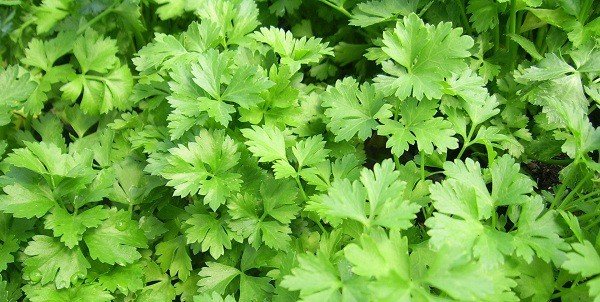Parsley

Parsley is a small annual plant from the umbelliferae family, its flowers are whitish or yellow-green, its leaves are double or triple branched.
Wild parsley grows along the Mediterranean coast. A cultivated one is grown all over Europe with the exception of the Scandinavian peninsula.
Nutritional value in 100 grams
• Proteins – 3.7 grams;
• Fats – 0.4 grams;
• Carbohydrates – 7.6 grams;
• Mineral composition – 1.1 grams;
• Water – 85 grams;
• Caloric content – 49 kilocalories;
Parsley – useful properties
Parsley contains a huge amount of various useful substances: vitamins A, C, E, K, from group B, folic acid, niacin /vitamin PP/, magnesium, potassium , calcium, sulfur, chlorine, phosphorus, sodium, iron, iodine, manganese, copper, zinc, fluorine.
In the first place, in terms of vitamin C content, parsley is not inferior to citrus fruits and even black currants, in which ascorbic acid is 4 times more than lemons.
It is enough to eat 50 grams of this annual plant per day, so that a person can get the necessary amount of vitamin C for one day.
Ascorbic acid prevents premature aging of the body, neutralizes damaging reactive oxygen molecules in the body and most importantly maintains its immune function at a sufficiently good level.
Strong anti-inflammatory properties make it extremely useful for dealing with a cold that has just begun to develop.
This spice is an excellent remedy for lack of good appetite, anemia, anorexia, depression, ulcer and gastritis and for chronic rheumatism and digestive disorders.
Parsley is indispensable for regulating liver and kidney function, stimulates the secretion of digestive enzymes, whitens teeth, strengthens gums, strengthens intestinal peristalsis and normalizes metabolism.
In folk medicine, this spice is used to lower blood pressure and also as a choleretic, tonic and diuretic.
It is also used to normalize metabolism and glucose levels. And due to the content of the polysaccharide inulin in parsley, the absorption of manganese is improved, which is very useful for restoring bone tissue.
This spice can also be used as a natural breath freshener and even helps eliminate the strong smell of garlic.
In order to maintain the normal functioning of the adrenal and thyroid glands, as well as to strengthen the blood vessels, nutritionists recommend the use of parsley juice.
This drink is successfully used as a medicine against diabetes, conjunctivitis, ophthalmia, cataracts, against some diseases of the urogenital tract, ascites and to improve the function of the cardiovascular system.
Parsley is also widely used for cosmetic purposes. Due to the large amount of vitamin A in it, its use reduces swelling, redness, tones and protects against the formation of wrinkles on the skin.
The decoction of this spice is a very effective remedy against acne. The combined parsley and dandelion mask is suitable for sensitive skin.
Thanks to the beneficial properties of the green spice, the tone of the muscles of the uterus, intestines and bladder is improved.
Contraindications
The use of parsley is not recommended for people suffering from nephrolithiasis, inflammation of the bladder and kidneys, due to the established presence of oxalates in it, which could further worsen the condition of the patients.< /p>
Green spice is not suitable. It is not desirable to use this spice in large quantities by pregnant women, as this increases the risk of abortion.



